Supporting the Implementation of the Transformative and Urgent 2030 Agenda for Sustainable Development
Understanding the information and knowledge needs of those implementing the 2030 Agenda for Sustainable Development is prerequisite and a challenge for making the abundant knowledge derived from Earth observation and science usable. The urgency in the 2030 Agenda requires working at unprecedented pace and the organizations supporting the Agenda have to be responsive and agile. The transformative nature of the 2030 Agenda requires a new mindset. New ways of thinking and working for the achievement of the Sustainable Development Goals (SDGs) will lead to experimentation, innovation, and capacity building. Processes and tools need to be created for simplifying and translating the abundantly available knowledge into forms that are relevant, timely and actionable for the implementation of the 2030 Agenda.
Developing a Collaborative Platform in Support of the Implementation and Monitoring of the Sustainable Development Goals with Earth Observation and Model-Based Knowledge
Achieving the sustainable development targeted by the UN's Sustainable Development Goals (SDGs) depends on information and knowledge derived from Earth observations and models. GEO has the convening power to bring together those who can generate the knowledge and those who use the knowledge in developing and implementing policies for SDG implementation and monitoring. GEO also can facilitate and contribute to the development of a collaborative platform where providers, scientists, and policy makers can work together to co-design, co-create, and co-use the knowledge for monitoring and implementing the SDGs.
SCOPE AND OBJECTIVES OF THE WORKSHOP
The workshop aimed to facilitate the development of a collaborative platform where providers, scientists, and policy makers can work together in support of the 2030 Agenda for Sustainable Development. The workshop focused on specific examples, in particular those SDGs scheduled for reviewing by the High-Level Political Forum 2017. The workshop provided a forum to review the knowledge needs associated with the monitoring and implementation of the SDGs. Science communities can help to generate the required knowledge and translate it into actionable forms. Decision and policy makers engaged in the monitoring and implementation of the SDGs benefit from having improved access to applicable knowledge and knowledge-creating tools. A platform incorporating this knowledge and tool set would support building new capacity in using this knowledge for policy making and the planning of action to implement the SDGs.
The development of evidence-based policy options that consider the SDG interactions must have a high priority. The scoping of a collaborative platform that would support the development of policy options accounting for SDG interactions, allow for gap analyses, and provide access to knowledge, including the documentation of use case and stories, was the theme linking the different parts of the workshop. Importantly, the relationship of such a platform to other effort such as the Global Partnership for Sustainable Development Data and the SDG Knowledge Action Network of “Future Earth” was considered.
The objectives of the workshop were to:
- Explore approaches to linking the Earth observation communities engaged in GEO to those communities monitoring the progress towards SDG targets;
- Better understand the needs to support through observations and models the policy development for SDG target implementation;
- Discuss gaps in observation and modeling support for SDG monitoring and implementation and means to address these gaps;
- Scope a collaborative platform, which supports the co-creation of and access to the knowledge required for the implementation and monitoring of SDGs, including initial considerations of the institutional framework the platform is meant to support.
The workshop specifically focused on one or more of the SDGs scheduled to be reviewed by the High-Level Political Forum 2017 (July-10-19, 2017, UNHQ, New York, see https://sustainabledevelopment.un.org/hlpf). These are:
- Goal 1. End poverty in all its forms everywhere
- Goal 2. End hunger, achieve food security and improved nutrition and promote sustainable agriculture
- Goal 3. Ensure healthy lives and promote well-being for all at all ages
- Goal 5. Achieve gender equality and empower all women and girls
- Goal 9. Build resilient infrastructure, promote inclusive and sustainable industrialization and foster innovation
- Goal 14. Conserve and sustainably use the oceans, seas and marine resources for sustainable development
OUTPUT
The anticipated outputs of the workshop include a document reviewing the interactions betweeen selected SDGs as well as describing the knowledge needs associated with policy development for the implementation of SDGs and the monitoring of the SDGs. The document will also define the functions, architecture and design of a collaborative platform where providers and user can work together to create and use this knowledge in support of SDG implementation and monitoring. It is expected that a draft is available at the end of the workshop, which will be iterated subsequently with relevant GEO and SDG communities.
PROGRAM AND SCHEDULE
SCHEDULE
Overview December 9-10, 2016
Note that the Session titles are preliminary and may change to some extent in the next weeks.
| Date |
|
|---|
| Friday, December 9, 2016 |
| 08:30-09:00 | Registration; Room: 145 |
| 09:00-10:30 | Session 1: Societal Knowledge Needs for Sustainable Development
Co-Chairs: Hans-Peter Plag and Norman Miller; Room: 135 |
| 10:30-11:00 | Coffee Break |
| 11:00-12:30 | Session 2: Interconnection and Interaction of SDGs
Chair: Rick Lawford; Room: 135 |
| 12:30-13:30 | Lunch |
| 13:30-15:30 | Session 3: Monitoring Progress Towards Goals: The Information Needs and Gaps; Room: 575
Co-Chairs: Giovanni Rum, Argyro Kavvada |
| 15:30-16:00 | Coffee Break |
| 16:00-17:30 | Session 4: Evidence-Based Policy Options for Implementing Goals: Knowledge Needs and Gaps
Co-Chairs: Jay Pearlman, Richard Bernknopf; Room 575 |
|
| Saturday, December 10, 2016 |
| 08:30-09:00 | Registration |
| 09:00-10:30 | Session 5: Adding Models to Earth Observations
Chair: James Syvitski; Room: 575 |
| 10:30-11:00 | Coffee Break |
| 11:00-12:30 | Session 6: Building Capacity for Evidence-Based Policies for Sustainable Development; Room: 575
Co-Chairs: Douglas Cripe, Argyro Kavvada
|
| 12:30-13:30 | Lunch |
| 13:30-1600 | Session 7: Developing a Collaborative Platform: The role of the GEOSS Knowledge Base
Co-Chairs: Hans-Peter Plag, Stefano Nativi; Room: 575 |
|
|
The program and the individual contributions was guided by the "Key Take Aways" from the launch of the IISD SDG Knowledge Hub:
- “We have an abundance of knowledge, not a shortage. Our true challenge is to better understand the needs of those implementing the 2030 Agenda so that we can more effectively match supply and demand.
- We need creative mechanisms for simplifying and translating knowledge into forms that are relevant, timely and actionable.
- A transformative agenda requires a new mindset, business as usual will not do. We must change the way we think and work to achieve the SDGs.
- This new mindset must include a massive boost in experimentation, innovation, and capacity building at all levels – multilateral, national and local.
- The 2030 Agenda requires working at an unprecedented pace. We should consider how we can improve our own organizations' ability to be responsive and agile in this fast-paced implementation period. ”
| 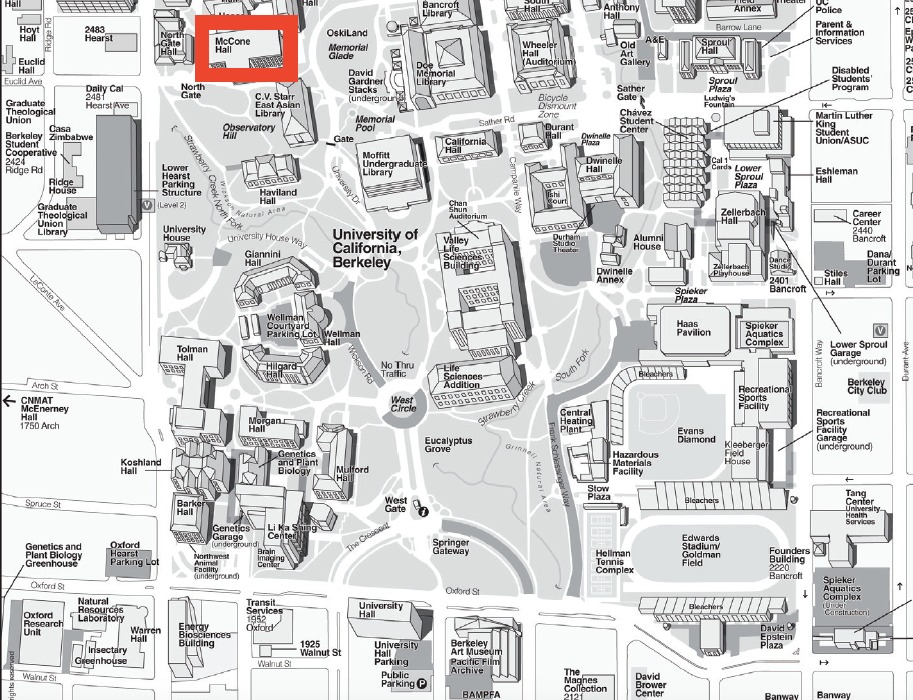
The meeting was at McCone Hall, in Room 575. |
PROGRAM
Friday, December 9, 2016
| 0830 - 0900: | Registration (Room 575) |
| 0915 - 1100: | Session 1: Linking Societal Knowledge Needs for Sustainable Development to Transformation Knowledge (Co-Chairs: Hans-Peter Plag and Norman Miller) |
| 0915 - 0925 | Norman Miller, University of California, Berkeley : Welcome and Opening Remarks |
| 0925 - 0945 | Giovanni Rum, GEO Secretariat: Expectations to the Workshop (presentation) |
| 0945 - 1020 | Einar Bjorgo UNOSAT Manager, UNITAR: UNOSAT's strategy to support Agenda 2030
|
| 1020 - 1110 | Steven Hagan, Oracle: IT Innovations Powering Future GEOSS Systems: Big Data, GeoData, Graph, Sensors, Linked Data, Knowledgebase, Cloud (presentations) |
| 1110 - 1140: | Coffee Break |
| 1140 - 1310: | Session 2: Interconnection and Interaction of SDGs (Co-Chairs: Rick Lawford and Hans-Peter Plag, Room 575)
|
| 1140 - 1210 | Hans-Peter Plag, Old Dominion University: Challenges and Workshop Goals (presentation)
Challenges: Whole-Society Effort, Process Output, Collaborative Platform |
| 1210 - 1240 | Rick Lawford: Introduction to SDG 2 Discussions (presentations)
| | 1240 - 1310 | Brian Walsh, IIASA (et al.): Food security and SDG Nexus (abstract, presentation)
|
| 1310 - 1400: | Lunch |
| 1400 - 1530: | Session 3: Monitoring Progress Towards Goals: The Information Needs and Gaps (Co-Chairs: Giovanni Rum, Argyro Kavvada, Room: 575) |
| 1400 - 1425 | Phil Dickerson, EPA: Air Quality |
| 1425 - 1450 | Rick Lawford, Morgan State University: Possible directions for integration: The WEF Nexus and SDGs (presentations
|
| 1450 - 1510 | Giovanni Rum, GEO Secretariat: GEO's contribution in support of SDG monitoring (presentation) |
| 1510 - 1530 | Lee Hall: Energy MonitoringAir Quality (presentation) |
| 1530 - 1550 | Brice Mora, Wageningen University: Monitoring progress towards Sustainable Development Goals: the role of land use & land cover (change) monitorings (abstract, presentation)) |
| 1550 - 1610 | Panel Discussion: Facilitating Data Integration and Aggregation at multiple Scales. Panel: Jay Pearlman, Richard Bernknopf, Brice Mora, Chair: Douglas Cripe
Challenges: Air Quality, Interoperability, Data Integration and Multiple Scales
|
| 1610 - 1630: | Coffee Break |
| 1630 - 1800: | Session 4: Evidence-Based Policy Options for Implementing Goals: Knowledge Needs and Gaps (Co-Chair: Jay Pearlman, Room 575) |
| 1630 - 1645 | Jay Pearlman: Evidence-Based Policy Options for Implementing Goals: Knowledge Needs and Gaps (presentation) |
| 1645 - 1800 | Panel Discussion: What are pathways to the creation of transformation knowledge?
Panel: Richard Bernknopf, Brain Walsh, Mary Hill, Norman Miller, Hans-Peter Plag; chair: Juli Trtani
Challenges: Whole-Society Effort, GEOSS Solution Compendium, User Engagement
|
| 1830 - 2100: | Social Dinner (no host) |
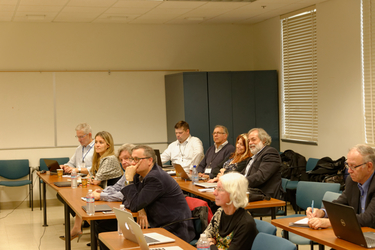 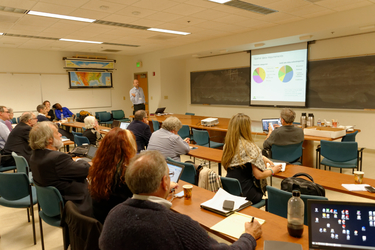 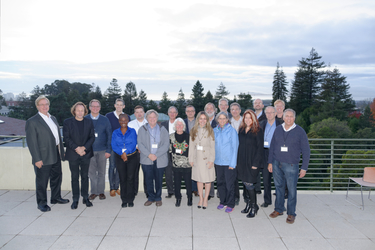 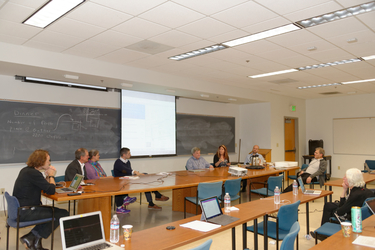
Saturday, December 10, 2016
| 0830 - 0900: | Registration |
| 0900 - 1030: | Session 5: Adding Models to Earth Observations (Chair: James Syvitski, Room: 575)
|
| 0900 - 0915 | James Syvitski: Session Goals (presentation) |
| 0915 - 0935 | Stefano Nativi: GEOSS Activities for SDGs: Model Webs to answer "what if" questions (abstract, presentation) |
| 0935 - 0955 | Mary C Hill (KU), Ruth Douglas Miller (KSU), Danny Rogers (KSU), and Joshua Roundy (KU): A Food-Energy-Water Calculator, with initial application to Western Kansas (abstract, presentation) |
| 0955 - 1015 | Robert Barron: Integrated Assessment Based Analysis of Sustainable Development Goal Interactions and Implementation Policies (abstract, presentation) |
| 1015 - 1030 | All: Discussion: Coupled Agent-Based and Equation-Based Models: Can they Produce Transition Knowledge?
Challenges: GEOSS Solutions Compendium |
| 1030 - 1100: | Coffee Break |
| 1100 - 1230: | Session 6: Building Capacity for Evidence-Based Policies for Sustainable Development (Co-Chairs: Douglas Cripe, Argyro Kavvada, Room: 575)
|
| 1100 - 1115 | Douglas Cripe: Session Goals |
| 1115 - 1135 | Werner Balogh (presented by Douglas Cripe): Development of a Space Capacity Index (SCI) and a Space Solutions Compendium (SSC) |
| 1135 - 1155 | Argyro Kavvada: SDG Initiative: EO in Service of the 2030 Agenda and Capacity Building (presentation) |
| 1155 - 1205 | Hans-Peter Plag: NASA DEVLEOP: Capacity Builidng for SDG-Related Monitoring |
| 1205 - 1230 | Panel Discussion: Options for GEO-Facilitated Capacity Building at National, Regional, and Global Levels
Panel: Argyro Kavvada, Nancy Searby, Rick Lawford, Chair: Douglas Cripe
Challenges: Capacity Building and Networking, Capacity Building |
| 1230 - 1330: | Lunch |
| 1330 - 1600: | Session 7: Ideation: Seeing the world through the eyes of the SDGs (Co-Chairs: Hans-Peter Plag, Stefano Nativi, Room 575)
|
| 1330 - 1340 | Hans-Peter Plag: Ideation: Seeing the World Through the Eyes of a SDG (presentation) |
| 1340 - 1545 | All: Ideation for SDG2: No Hunger - Chairs: Shelley Jules-Plag and Hans-Peter Plag |
| 1545 - 1600 | Hans-Peter Plag and Stefano Nativi: Summary and Outlook: Progress towards a paradigm |
Abstracts
Integrated Assessment Based Analysis of Sustainable Development Goal Interactions and Implementation Policies.
Robert Barron, University of Kansas, Lawrence, KS
Achieving the goals of the 2030 Agenda for Sustainable Development will require comprehensive policy measures that span socioeconomic, environmental, and geographic boundaries. Although each of the seventeen Sustainable Development Goals (SDG)s targets a specific area of improvement, the numerous interactions between the SDGs call for a holistic approach to SDG-oriented policy making. Integrated Assessment Models (IAM)s are designed to examine the large scale interactions between human and natural systems and have been widely used in climate policy research. This talk presents examples of how IAMs could play an important role in GEO’s proposed collaborative platform for knowledge generation and policy analysis. We begin by illustrating how IAMs can be used to analyze interactions between SDGs by discussing the interactions between SDG 2 (zero hunger), SDG 9 (industry, innovation, and infrastructure), SDG 7 (affordable and clean energy), and SDG 13 (climate action). Next, we illustrate how IAMs can be used to conduct tradeoff analyses of policy measures, quantify policy impacts, and highlight knowledge gaps. We conclude with a discussion of how IAM analysis can be integrated into GEO’s proposed collaborative platform, the steps needed to accomplish this integration, and proposed research that will support that goal.
IT Innovations Powering Future GEOSS Systems: Big Data, GeoData, Graph, Sensors, Linked Data, Knowledgebase, Cloud
Steven Hagan, Oracle, New England Development Center, Nashua, New Hampshire
There are many challenges to developing robust GEOSS earth observation systems, processing services, and publishing portals. A tremendous amount of scientific expertise and experience has been invested over the years to deliver meaningful scientific results to the research community and the public. Similarly, there is a rapid and ongoing innovation in the IT community that may be helpful to future GEOSS investments. The purpose of this talk is to highlight relevant technologies and innovations may address current and future GEOSS challenges. In many ways, the process of collecting, managing, and publishing EO data is not dissimilar from the processes that online publishing, social media, and shopping sites perform. The underlying platform technologies used to deploy scalable, secure and collaborative performance media solutions to customers worldwide, are likely quite similar. Hence, this talk attempts to share some exciting IT innovations that are likely to be incorporated into future GEOSS solutions.
While there is no single killer app (or silver bullet) that can satisfy unique IT requirements of a federated earth observation system, there are relevant technologies and best practices that can be learned from experiences of the IT community. This talk highlights four exciting new technology areas and their relevant to the GEOSS community.
- a) Big and Fast Data Platforms (Relational, Hadoop, NoSQL, IoT systems): In the past decade there has been rapid innovation in data management and processing. Specialized data platforms have emerged to complement the capabilities of relational systems by introducing capabilities like horizontal scalability, MapReduce processing, efficient bulk loading and update performance, real-time processing, of large volumes raster imagery files etc. The talk will highlight the role these technologies play across the GEOSS community.
- b) Consolidated Geospatial Data Platforms (image processing, GIS, spatial databases, tracking/sensor systems): The GEOSS community handles a large variety of geospatial data daily. However, there has been a tendency to manage each spatial data type (vector, raster, array, TIN, point cloud, trajectories) in separate purpose built systems. The talk illustrates how organizations overcome this stove-piping, by delivering a consolidated geospatial processing and analysis platforms. There are also new geo-enrichment technologies that can tag social media to further enhance spatial analysis, or as a stand-alone analytical process.
- c) Linked Data and Knowledge Management (RDF, ontologies, and reasoning systems): The talk will highlight how W3C Linked Data standards can be applied to enhance GEOSS federated catalog systems, while also being used to build centralized publishing portals. Similarly, the combination of ontologies and logic rules can be applied to data and process models that are a foundation for any knowledgebase. These reasoning-based techniques are also applicable to data and model validation, as well as model-based processing.
- d) Graph Processing and Analytics (recommender systems, social network analysis, dependency graphs): Interest in graph databases is skyrocketing due to the rich insight it brings to conventional data analysis and mining techniques. For example: recommending relevant scientific data on the GEOSS portal site to its online users; mining and finding influencers in published literature; detecting clusters and anomalies in monitored data; modeling and visualizing complex interdependences in ecosystems.
Finally, since new IT solutions are now deployed “in the cloud”, it's important to understand the implications of this deployment paradigm. The talk outlines two common options: Cloud and Hybrid Cloud.
The audience will come away with: a primer on when to make use of Big Data, Fast Data and relational database platforms; how to leverage existing geospatial technology to minimize stovepipes and consolidate spatial data management and analysis requirements; how to apply a collaborative Linked Data approach data federation, and ontologies and reasoning to curate knowledge systems; how to apply graph analysis on data entities to undercover patterns and clusters; and finally, understanding Cloud deployment options.
A Food-Energy-Water Calculator, with initial application to Western Kansas
Mary C Hill (KU), Ruth Douglas Miller (KSU), Danny Rogers (KSU), and Joshua Roundy (KU)
Many agricultural areas are facing difficult local circumstances, some of which pose challenges to attaining the Sustainable Development Goals (SDBs). Kansas is one example, with problems typical of other national and global locations. Past agricultural and hydrologic data document how irrigation in western Kansas has produced a multi-billion-dollar agricultural economy that is now threatened by pumping-induced declines in groundwater storage. A disincentive of reducing pumping is the economic impact of diminished irrigation. One alternative is a water-energy tradeoff that seeks to enable enduring use of the Ogallala aquifer while maintaining local income levels through development of the rich regional wind and solar energy resources in a way that enhances local economic benefits. In considering this alternative, most citizens are currently unable to address a key question, “What could this mean for me?” Answers require knowledge of agriculture, energy, water, and drought probabilities. This knowledge is available at Kansas universities, and needs to be communicated to the people. This talk presents a University of Kansas-Kansas State University effort to address this need through development of the Food-Energy-Water Calculator. The talk will present the idea and discuss how the calculator would work. It is suggested that the proposed framework would provide a powerful way to organize data and analysis results for use by individuals, families, and communities. Working at this personal level is critical to attaining the SDGs.
Monitoring progress towards Sustainable Development Goals: the role of land use & land cover (change) monitorings
Brice Mora, GOFC-GOLD LC Project Officer, GFOI R&D Coordination Leader
The GOFC-GOLD Land Cover Project Office performed an analysis of the current list of goals, targets and indicators within the scope of its land monitoring activities. The analysis aimed to 1) identify which goals, targets and indicators land cover / land use data can support, 2) identify gaps and needs, in terms of data, and indicators (are indicators specific enough to gather information relevant for the targets?). We conclude notably that some targets can be served already, and that some indicators are not sufficient to be monitored and require specific attention. Still goals/targets can benefit from already working/ anticipated programs (i.e. goal 13 Climate action & goal 15 Life on land). There is also a need for dialogue between SDGs indicator developers and technical community to assess gaps and further development of indicators.
GEOSS Activities for SDGs: GEO Model Web to answer "what if" questions
Stefano Nativi, CNR, Italy
The presentation will briefly recall the GEO Model Web vision and principles. It will discuss the need to include in GEOSS processing services and models, in addition to data. Finally, it will introduce the recent developments and the future challenges for implementing the GEO Model Web, in the light of supporting SDGs realization.
Food security and SDG Nexus
Brian Walsh et al., IIASA
The 17 Sustainable Development Goals (SDGs) call for a comprehensive new approach to development rooted in planetary boundaries, equity, and inclusivity. The wide scope of the SDGs will necessitate unprecedented integration of siloed policy portfolios to work at international, regional, and national levels toward multiple goals and mitigate the conflicts that arise from competing resource demands. In this analysis, we adopt a comprehensive modeling approach to understand how coherent policy combinations can manage trade-offs among environmental conservation initiatives and food prices. Our scenario results indicate that SDG strategies constructed around Sustainable Consumption and Production policies can minimize problem-shifting, which has long placed global development and conservation agendas at odds. We conclude that Sustainable Consumption and Production policies (goal 12) are most effective at minimizing trade-offs and argue for their centrality to the formulation of coherent SDG strategies. We also find that alternative socioeconomic futures—mainly, population and economic growth pathways—generate smaller impacts on the eventual achievement of land resource–related SDGs than do resource-use and management policies. We expect that this and future systems analyses will allow policy-makers to negotiate trade-offs and exploit synergies as they assemble sustainable development strategies equal in scope to the ambition of the SDGs.
Challenges in Linking SDGs to Data, Models and Capacity Building
The following Challenges have been identified by Program Committee members and invited contributors. The challenges provide guidance for the workshop discussion and most of them will be addressed specifically during the sessions.
Douglas Cripe/Andiswa Mlisa - Capacity Building: The GEO Capacity Building Portal (GEO CAB) exists, yet needs a considerable amount of additional input and polishing (http://www.geocab.org/).
Some issues include:
- How can the portal be improved and the tools there better exploited, or even connected to the GEO knowledge base?
- There should be some type of link to the CAB, enabling people to access resources/capacity building to help achieve national progress on the SDGs.
- Related to 2, what capacity building activities are needed to teach people to make informed decisions in relation to the SDGs?
- How should capacity building be framed in the context of EO4SDGs (aka GI-18)?
Phil Dickerson - Air Quality: Traditional monitoring networks are expensive and often beyond the capacity of developing nations. Much research has shown that remote sensing data can be used as a good estimate of PM2.5 levels, when fused with available in-situ monitoring. In particular, US EPA’s AirNow Satellite Data Processor (ASDP) uses a daily composite of MODIS from Aqua and Terra, fused with in-situ observations, to create a daily nationwide PM2.5 surface.
ASDP was completed under a NASA ROSES project that ended in 2013. Since that time, small sensor packages have appeared and are rapidly being adopted by researchers and communities to make short term measurements with highly portable, relatively inexpensive equipment.
Given the availability of small sensors, and the growing body of research on fusion of remote sensing and in-situ data, the challenge remains to integrate all those measurement sources to better characterize PM2.5. A particularly intriguing aspect of this challenge is the very different time scales of these measurements – ranging from one minute for small sensors, to as much as 24 hours for satellite measurements.
This challenge relates directly to SDG 3, Goal 3: Ensure healthy lives and promote well-being, and the associated Target 3.9: Substantially reduce the number of deaths and illnesses from hazardous chemicals and air, water and soil pollution and contamination. Better characterization of short term PM2.5 exposure allows citizens to plan activities to minimize exposure during the highest hours. Indicator 3.9.1: Mortality rate attributed to household and ambient air pollution, also applies, as mortality may be reduced.
Goal 11: Make cities & human settlements inclusive, safe, resilient and sustainable, Target 11.6: Reduce the adverse per capita environmental impact of cities, and associated Indicator 11.6.2: Annual mean level of PM 2.5 & PM 10; also applies to this challenge. More comprehensive characterization of PM2.5 concentrations, at smaller time scales and with greater spatial coverage, allows a better estimate of actual exposure to individuals.
While a great deal of research is available on human exposure to PM2.5 and resulting morbidity and mortality, there is a potential gap internationally in terms of ambient concentrations, short term exposures, and mitigative actions. The best possible data and estimates regarding PM2.5 concentrations in near-real-time can lead to greater public awareness, as well as driving forecast programs that may allow citizens to reduce overall exposure.
Argyro Kavvada -Capacity Building and Networking: One big challenge for the implementation of the Agenda 2030 is to build capacity and transfer knowledge in a more comprehensive and inclusive way, in which all stakeholders participate (e.g., in-line ministries, national statistical offices, local governments, NGOs, private sector, and civil society etc.). How can we connect international efforts in a more coordinated manner to regional and country-level efforts to facilitate knowledge sharing and avoid overlap? Additionally, how can we work to help harmonize and share the work completed by different country institutions to enable inter-sectorial coordination and support existing, and emerging, national SDG monitoring and reporting platforms? How can capacity building activities help foster national ownership of the 2030 Agenda for Sustainable Development?
Stefano Nativi - Knowledge Base: What is the role of GEOSS Knowledge Base in the GCI Evolution? GCI is required to evolve and move from a data sharing infrastructure to an information and knowledge sharing platform: this will require to support new types of resources (e.g. workflows, models, knowledge bodies) in order to better and further understand and connect shared datasets. What of these components and capabilities might or should be managed by the GEOSS Knowledge Base? What should be the process to collect and manage them? How the Knowledge Base should contribute to the GCI evolvement?
Jay Pearlman - Interoperability: A major challenge comes from the fact that SDG goals are inter-related. And the relations lead to the complexity that addressing one goal alone may not created balanced and sustainable solutions. For example oceans (SDG 14) impact food, energy, climate, health and the general welfare of humanity. Understanding these relations is the first part of the challenge. The second part is that each of the SDGs has its own information demands with the resulting information have different formats and language. Many times the information may even be stove-piped and support solution of one SDG. For a knowledge-base to address multiple SDGs, a new level of interoperability is necessary - one that is technical, social and cultural. Identifying informaiton required and the process to make it readily accessible and understandable is a major challenge.
Process output: Process outputs from the workshop may be as important as end outputs: Thus the process to get interdisciplinary cooperations to develop metrics and monitoring is as much a challenge as the definition of the metric. Thus we need to understand if a process involves sociotechnical models which may not exist but could be synthesized from existing models. The SDGs are a balance of competing interests at a national, regional or even local levels (e.g.coal mining in parts of Wyoming). I see economic science in the agenda. Is political science also in the mix?
Hans-Peter Plag - Whole-Society Effort: Achieving the SDGs is an herculean challenge for humanity demanding novel ways in governance and new means to connect the policy makers to knowledge and evidence. Many of the 17 goals address problems that humanity has been dealing with for decades, centuries and, in some cases, millenniums. Having less than 15 years to reach the goals makes the Agenda 2030 an onerous one. Many aspects of the current trajectory of society embedded in the Earth's life-support system are pointing away for the SDGs, not towards them. Unparalleled interventions are need to change the trajectory and point it towards the SDGs. Progress towards the SGDs is not something some governments can achieve or facilitate, it requires a whole-society effort with the leading players in each sector being involved and taking responsibility. Science and Earth observations can play crucial roles but only if they are integrated into the whole-society effort. What is needed to facilitate this? How can we link those engaged in developing policies, regulations, practices, and other means for the implementation of the SDGs to the knowledge they need, knowledge that tells them what would work, keeps them informed about what others are doing, provides a comprehensive picture of what is working, helps them to compare their own successes to those of others, and identifies new challenges that arise along the way? What role could GEO play in facilitating this link?
Giovanni Rum - Collaborative Platform: There is abundance not only of knowledge (somehow scattered in different communities) but also of platforms/frameworks being developed to provide the actual “place” where all these different communities + “decision-makers” could meet and jointly agree what is needed and what to develop. A challenge will be to give to the collaborative platform we want to develop a clear connotation and also clear linkages/interfaces with other initiatives having similar objectives. (I’m making a rather sound assumption that several platforms will operate and coexist)
From a general perspective, if this will be a GEO platform, EO should clearly be the reference; in a way, we would invite other communities to work together with the GEO Community to develop those models that would allow bringing in EO derived information into decision/policy making processes. From one side this is OK, because the EOs are probably the best reference to frame other information (clearly defining the what, the where and the when).
What will this platform deliver? “Generic” information? Specific services? (Projections. Simulations, what if scenarios – like the tool developed by the Millennium Institute-, just a place to exchange best practices? )
Who will “produce” the services?
How do we structure the interaction user-developers-providers, taking into account the need of co-creation but also of the respective roles in an “operational” environment?
What is(are) the profile(s) of the “users” we assume will be served/interacting? The platform may look very differently.
Michel Schouppe - Data Integration and Multiple Scales: Particular challenges of interest relate to the integration of multiple data sources to feed the model web concept; the multiple scale approach of the SDGs from global to local scale (including the disaggregation aspects); User Engagement in a complex international coordination landscape. I like the idea of solutions compendium (proposed under session 6 by Doug). Still, given the wide EO scope of GEO, it would be nice to think in terms of GEOSS solutions compendium instead of space solutions compendium. Last remark: be careful not to fall into an ICT-driven SDG workshop, rather than user-driven SDG workshop. IT-innovations, collaborative platforms are the necessary means to achieve the SDG aims, not the reverse
PRACTICAL DETAILS
PARTICIPATION
The Workshop is open to all interested providers and users of knowledge related to the implementation and monitoring of the SDGs, particularly those engaged in creating relevant knowledge based on Earth observations and models and those involved in developing and implementing policies for the SDGs.
DEADLINES
The following deadlines have been defined:
- Submission of abstracts: November 15, 2016.
- Registration deadline: December 1, 2016.
COMMITTEES
Local Organizing Committee:
- Norman Miller
- Hans-Peter Plag
Program Committee:
- Richard L. Bernknopf
- Douglas Cripe
- Phil Dickerson
- Lawrence Friedl
- Shelley Jules-Plag
- Argyro Kavvada
- Rick Lawford
- Norman Miller
- Joan Maso
- Stefano Nativi
- Jay Pearlman
- Hans-Peter Plag
- Giovanni Rum
- Michel Schouppe
- Andy Stevens
- James Syvitski
- Juli Trtanj
ACKNOWLEDGEMENTS
Support for the Workshop
 |
The workshop is organized by the GEOSS Science and Technology Stakeholder Network. |
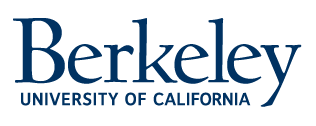 |
The workshop is hosted by Berkeley, University of California. |
 |
The workshop organization is supported by the GEO Secretariat. |
 |
Tiwah supports the Workshop by hosting and maintaining the GSTSS. |
Technical Advice and Support for the Workshop
ABSTRACTS
Speakers are asked to submit abstracts for their presentations. Abstract can be submitted by sending the abstract to hpplag @ odu.edu. Abstracts will be included in the program pages.
REGISTRATION
Pre-Registration is strongly recommended before November 15, 2016 to help the organizers in the planning of the events. To register, please send a mail to Hans Peter Plag.
If you plan to present at the workshop, please use the abstract submission page to submit an abstract.
VENUE
The 5th GEOSS Science and Technology Stakeholder Workshop will take place at the University of California Berkeley, Berkeley, California, USA. The meeting will be at McCone Hall, marked in red in the campus map shown below. The meeting is in room 135 McCone on Friday from 8:30-12:30 and then in room 575 McCone Friday afternoon and all day Saturday.

LOGISTICS
Contents
Travel Logistics
Getting to Berkeley, California and University of California, Berkely:
- By car: tba
- By public transportation from the San Francisco or Oakland Airports: Both the San Francisco and Oakland airports are well connected to Berkely with the Bay Area Rapid Transit (BART). A map of the BART system is available on the BART web page.
Back to contents
Climate and Weather
|
Climate in Berkely in December is moderately cool and wet. The average highs and lows in December are 14.9oC and 5.3oC and December is the wettest month with an average precipitation of 128 mm (see U.S. Climate Data for more details).
| 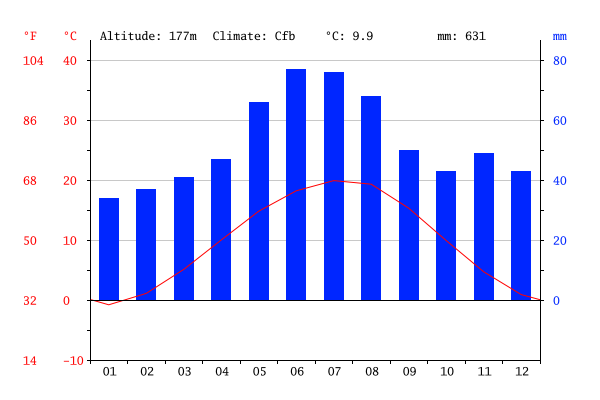
|
For weather, see the most recent seven-day forecast for Berkely provided by the National Weather Service or the ten-day forecast by Wunderground.
Back to contents
Restaurants
There are many restaurants in the vicinity of the meeting venue. More information on restaurants will be added here soon.
Back to contents
Workshop Dinner
Depending on interest, a no-host dinner may be organized on the evening of December 9, 2016.
Back to contents
What to do and visit in Berkeley?
Abundant information on what to do and visit in Berkeley or the nearby cities is available on the Web, e.g., at http://www.visitberkeley.com or http://www.berkeley.edu/about/visit.
Back to contents
ACCOMMODATION
Suggested hotels near UC Berkeley (Hotel Durant is closest to the meeting venue):
Rose Garden Inn, Guest rating: 3.5, 3-star hotel: Historic mansion offering traditional rooms plus breakfast, free WiFi and a garden. Free breakfast. Typical room rate: $185
Quality Inn University, Guest rating 3.5, 2-star hotel: Relaxed hotel offering traditional rooms with free Wi-Fi & continental breakfast. Free Wi-Fi, Free breakfast, typical room rate: $229
Hotel Durant, Guest rating: 3.8, 3-star hotel: Collegiate-themed property with traditional (but whimsical) library furnishings and a gastropub. Free Wi-Fi. Typical room rate: $230
Hotel Shattuck Plaza, Guest rating 4.2, 4-star hotel: Stately hotel offering modern quarters with free WiFi, plus a refined restaurant and a bar. Free Wi-Fi.
|









